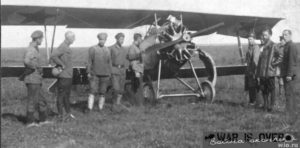15th September 1918 Sunday
Panic Ensues, but only Douglas Spots the Enemy Overhead
All material produced or reproduced here and throughout this work is the sole copyright of the author and the family of Doctor D.C.M. Page MC.
“Sunday September 15th. Quite an exciting day. It all began about ten o’clock in the morning, when one of Capt. Merchant’s marines came galloping into the village mounted on a small pony, with a note to the effect that Bolsheviks had been spotted and fired on. Almost immediately after in galloped one of our cavalry scouts with the news that the enemy were in the woods about three versts from the village, and that one of his comrades had been fired on and his horse killed.
At this point of the proceeding Scott ordered the alarm to be sounded – the church bell rung vigorously. What a scene followed! All the drosky-drivers ran pell-mell for their carts, and got ready to bolt at a moment’s notice. The peasants came rushing out of their houses to see what was the matter. As soon as they heard the news an awful moaning arose. Women rushed out into the fields to bury their valuables, and bring their sheep and cattle back to the village. It was a sad sight.
The Americans went out to man the trenches that had been dug just outside the village, and extra French machine-guns were put into positions on the hill above the village. Cavalry patrols were sent out to patrol the roads behind the village, and some came back with the report that they had heard rifle shots in the direction of Teogra! This put the ‘wind-up’ us, for we wondered if we had been surrounded. A party of Royal Scots was sent along to reinforce the outpost on the bridgehead near Teogra. Later we discovered that the firing heard by the patrol was the firing in front of us at Seletskoe!
I procured two carts, and got my stores loaded up ready to move off at a moment’s notice. I heard several bursts of M.G. fire about 10.30 a.m., and again about one o’clock. I took a walk up the road to the top of the hill overlooking the Bolshevik positions, but could see nothing unusual. I heard a few isolated rifle shots from the direction of the woods about half a mile off. There were no casualties up till one o’clock. The M.G. fire increased considerably in the afternoon, and Scott and Jerome had a pretty hot time going round the advanced posts. They had to do a good deal of ‘stomach’ work!
About four o’clock in the afternoon a Bolshevik aeroplane came over flying very low. Nobody seemed to realise that it was an enemy plane, with the result that it had a good look round without being fired at! I spotted at once that it was not a British machine by the markings on the wings – red outer ring with dirty bluey-white centre – and told Capt. Merchant so, but he took no action.
Soon after it had gone two enemy field guns opened fire on our advanced posts, but without doing any damage. Then our guns started firing, and soon there was a regular ‘battle’ as the Americans would say, in progress. The peasants had the ‘wind up’ properly, and one drosky driver dropped down dead in the street from fright. I had to give the good lady of our house a tot of rum, as she was bordering on hysterics. We gave her permission to send her children off to another village for safety. Everything quieted down at dusk. During the day we rounded up eight spies – seven men and a woman – and sent them down to Siskoe under escort.”

Probably the type of aircraft spotted by Douglas. A Red Army Nieuport 21. http://wio.ru/ww1a/n-gal.htm
Find out about our connection with Dr Page and an introduction to his diary here